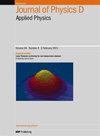Advances in optical recording techniques for non-invasive monitoring of electrophysiological signals
IF 3.2
3区 物理与天体物理
Q2 PHYSICS, APPLIED
引用次数: 0
Abstract
The study of electrophysiological signals is crucial for understanding neural functions and physiological processes. Electrophysiological recordings offer direct insights into electrical activity across cellular membranes, aiding in diagnosing and treating neurological disorders. Different from the conventional recording method based on electrical signals and the genetically encoded with fluorescent proteins methods, this review explores label-free mechanisms for optically recording electrophysiological signals: electrochromic materials, surface plasmon resonance (SPR) responses, quantum dots (QDs), and semiconductor-based optoelectronic sensors. The sophistication and limitations of each technology have been discussed, providing insights into potential future directions in this field. Electrochromic materials change optical properties through redox reactions induced by voltages, offering high signal-to-noise ratios and rapid response capabilities. However, these materials have limited biocompatibility and stability. SPR technology modulates signals in response to local changes in electrical potential, achieving high sensitivity. However, challenges such as scattering noise and electro-optic effects still need to be addressed. QDs utilize their photoluminescent properties for high sensitivity and resolution, but concerns about connection efficiency and biocompatibility remain. Semiconductor optoelectronic technologies offer rapid response times, wireless functionality, and integration potential. However, improvements are needed in terms of toxicity, compatibility with biological tissues, and signal amplification and processing. These methods have advantages in neuroscience, medical diagnostics, and biological research, including rapid response, high sensitivity, and label-free monitoring. By combining different optical recording techniques, the performance of voltage imaging can be optimized. In conclusion, interdisciplinary collaboration and innovation are essential for advancing the optical recording of electrophysiological signals and developing diagnostic and therapeutic approaches.用于无创监测电生理信号的光学记录技术的进展
电生理信号研究对于了解神经功能和生理过程至关重要。电生理记录可直接了解细胞膜上的电活动,有助于诊断和治疗神经系统疾病。与基于电信号的传统记录方法和荧光蛋白基因编码方法不同,本综述探讨了光学记录电生理信号的无标记机制:电致变色材料、表面等离子体共振(SPR)反应、量子点(QDs)和基于半导体的光电传感器。我们讨论了每种技术的先进性和局限性,为该领域未来的潜在发展方向提供了启示。电致变色材料通过电压诱导的氧化还原反应改变光学特性,具有高信噪比和快速反应能力。然而,这些材料的生物相容性和稳定性有限。SPR 技术可根据局部电位的变化调节信号,从而实现高灵敏度。然而,散射噪声和电光效应等挑战仍有待解决。QD 利用其光致发光特性实现高灵敏度和高分辨率,但连接效率和生物相容性仍令人担忧。半导体光电技术具有快速响应时间、无线功能和集成潜力。然而,在毒性、与生物组织的兼容性以及信号放大和处理方面还需要改进。这些方法在神经科学、医疗诊断和生物研究方面具有快速反应、高灵敏度和无标记监测等优势。通过结合不同的光学记录技术,可以优化电压成像的性能。总之,跨学科合作与创新对于推进电生理信号的光学记录以及开发诊断和治疗方法至关重要。
本文章由计算机程序翻译,如有差异,请以英文原文为准。
求助全文
约1分钟内获得全文
求助全文
来源期刊
CiteScore
6.80
自引率
8.80%
发文量
835
审稿时长
2.1 months
期刊介绍:
This journal is concerned with all aspects of applied physics research, from biophysics, magnetism, plasmas and semiconductors to the structure and properties of matter.

 求助内容:
求助内容: 应助结果提醒方式:
应助结果提醒方式:


